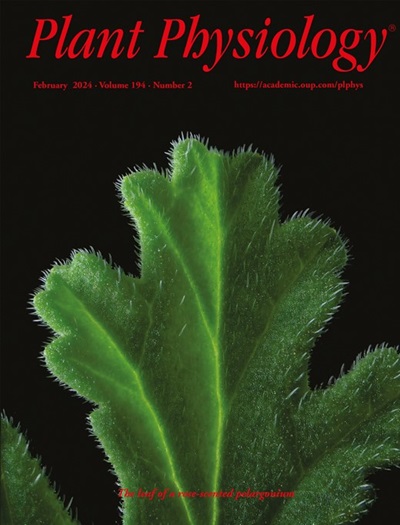Subcellular plant carbohydrate metabolism under elevated temperature
IF 6.5
1区 生物学
Q1 PLANT SCIENCES
引用次数: 0
Abstract
In many plant species, exposure to a changing environmental temperature regime induces an acclimation response that ultimately increases thermotolerance. Under elevated temperature, membrane systems undergo remodeling to counteract destabilizing thermodynamic effects. Elevated temperature also affects photosynthesis and carbohydrate metabolism due to altered protein functions, enzyme activities, and transport across membrane systems. Here, a combination of electrolyte leakage assays and chlorophyll fluorescence measurements was applied to quantify heat tolerance before and after heat acclimation in Arabidopsis thaliana under different temperature regimes. Subcellular carbohydrate concentrations were determined through non-aqueous fractionation and 3D reconstruction of mesophyll cells and subcellular compartments using serial block-face scanning electron microscopy. Across temperature regimes between 32 °C and 38 °C, seven days of heat acclimation at 34 °C most efficiently increased tissue heat tolerance. Under such conditions, cytosolic sucrose concentrations were stabilized by a shift in sucrose cleavage rates into the vacuolar compartment, while invertase-driven cytosolic sucrose cleavage was efficiently quenched by fructose and glucose acting as competitive and non-competitive inhibitors, respectively. Finally, this study provides strong evidence for a sucrose concentration gradient from the cytosol into the vacuole, which might directly affect the physiological role and direction of sugar transport across cellular membrane systems.高温条件下的植物碳水化合物亚细胞代谢
在许多植物物种中,暴露于不断变化的环境温度状态会引起驯化反应,最终增加热耐受性。在高温下,膜系统经历重塑以抵消不稳定的热力学效应。由于蛋白质功能、酶活性和跨膜系统运输的改变,温度升高也会影响光合作用和碳水化合物代谢。本研究采用电解质泄漏测定和叶绿素荧光测量相结合的方法,量化了拟南芥在不同温度条件下热驯化前后的耐热性。亚细胞碳水化合物浓度测定通过非水分离和三维重建叶肉细胞和亚细胞区室使用连续块面扫描电子显微镜。在32°C至38°C的温度范围内,在34°C下进行7天的热驯化最有效地提高了组织的耐热性。在这种条件下,由于蔗糖裂解速率向液泡区转移,胞质蔗糖浓度稳定,而果糖和葡萄糖分别作为竞争性和非竞争性抑制剂,有效地抑制了酶驱动的胞质蔗糖裂解。最后,本研究提供了强有力的证据,证明从细胞质溶胶到液泡的蔗糖浓度梯度可能直接影响糖在细胞膜系统中的生理作用和转运方向。
本文章由计算机程序翻译,如有差异,请以英文原文为准。
求助全文
约1分钟内获得全文
求助全文
来源期刊

Plant Physiology
生物-植物科学
CiteScore
12.20
自引率
5.40%
发文量
535
审稿时长
2.3 months
期刊介绍:
Plant Physiology® is a distinguished and highly respected journal with a rich history dating back to its establishment in 1926. It stands as a leading international publication in the field of plant biology, covering a comprehensive range of topics from the molecular and structural aspects of plant life to systems biology and ecophysiology. Recognized as the most highly cited journal in plant sciences, Plant Physiology® is a testament to its commitment to excellence and the dissemination of groundbreaking research.
As the official publication of the American Society of Plant Biologists, Plant Physiology® upholds rigorous peer-review standards, ensuring that the scientific community receives the highest quality research. The journal releases 12 issues annually, providing a steady stream of new findings and insights to its readership.
 求助内容:
求助内容: 应助结果提醒方式:
应助结果提醒方式:


